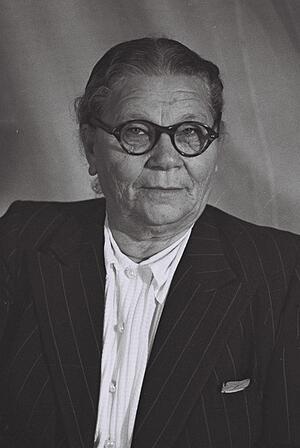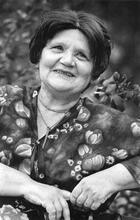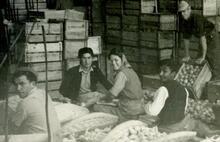Ada Maimon (Fishman)
One of the “spiritual mothers” of Jewish feminism in Israel, Ada Maimon served in a number of roles, including founding the women's labor organization, Mo'ezet Ha-Po'a lot, and serving in the first Knesset. Her public activity, together with her role as historian of the feminist movement in Israel, was part of a long, determined struggle on behalf of Jewish women in Israeli society and, even more, in the Jewish religion. In each of her many positions, she viewed her role as being a religious and spiritual one. In the Knesset, this attitude led her to oppose every law that granted perquisites and high salaries to public servants and to forgo most of her salary. Maimon’s lifelong devotion to public struggle greatly impacted Israeli society today.
Background
One of the “spiritual mothers” and historians of Jewish feminism in Israel, Ada Maimon was a teacher by profession and a member of Ha-Po’el ha-Za’ir from 1913 to 1920. She was also one of the founders of Mo’ezet Ha-Po’alot, the General Council of Women Workers in Israel, and its secretary-general from its founding in 1921 to 1926. When she completed her term of office she founded Ayanot, a women’s farm near Nes Ziyyonah. With the establishment of the state, she served as a Mapai party member of the first and second Knessets and was responsible for various laws related to women’s equality. Her public activity, together with her role as historian of the feminist movement in Israel, were part of a long, determined struggle on behalf of Jewish women in Israeli society and, even more pronouncedly, in the Jewish religion. This struggle led to frequent conflicts between Maimon and the leaders of the Histadrut and the Labor Party, as well as to arguments with representatives of the religious parties and the Israeli Orthodox establishment.
One of nine children, Ada Fishman was born in Marculesti, Bessarabia (Romania) on the Ninth of Av (July 22), 1893, and grew up as the daughter of a rabbi and scribe, Avraham Elimelekh Fishman (of the Maimon family) and Babeh Golda Fishman. In 1949, she and her brother Rabbi Juda Leib (1875–1962) changed their surname to Maimon to reflect their descent from Moses ben Maimon (Rambam), b. Spain, 1138Maimonides. Her family’s religious Zionist background led her to visit Palestine in 1908, together with her brother Juda Leib, one of the founders of the Orthodox Zionist Mizrachi movement, and to emigrate to Palestine as part of the Second Lit. "ascent." A "calling up" to the Torah during its reading in the synagogue.Aliyah in 1912. Early on in her life, her knowledge of classical and modern Jewish literature made her aware of—and opposed to—the inferior status of Jewish women. This opposition informed her lifelong career as an indefatigable fighter for women’s equality in the Israeli workers’ movement.
The Labor Movement
In 1913, a year after she moved to Palestine, Maimon became an active member of Ha-Po’el ha-Za’ir, the non-Marxist workers’ movement of the Jewish community in Palestine prior to the establishment of the State of Israel. "Old Yishuv" refers to the Jewish community prior to 1882; "New Yishuv" to that following 1882.Yishuv, whose members included most of the writers and philosophers of the Labor movement, such as Aharon David Gordon (1856–1922), Joseph Hayyim Brenner (1881–1921), Devorah Baron, and Joseph Aharonovitch (1877–1937). In 1914 the Teachers’ Association invited her to open a coeducational Hebrew school for the children of families of the Old Yishuv in Safed. At the time, most Jewish residents of the city sent their daughters to the local mission school but objected to the establishment of a secular Hebrew school in the city. While she was living in Safed, Maimon and two women friends attended the annual memorial celebration for Rabbi Shimon Bar Yohai (mid-second century c.e.) on Mount Meron, violating the Orthodox rabbis’ explicit ban on women’s presence there. When other women followed suit, the ban was abolished de facto.
During World War I, Maimon was a member of the first women workers’ committees, which met secretly to strengthen the women’s demand that they be represented on workers’ committees and their unique employment problems be addressed. Like the other women pioneers of the Second Aliyah, she worked by turns in education and in temporary agricultural labor until 1918, when she was offered the position of treasurer of the Ha-Po’el ha-Za’ir party’s newspaper. Still, she continued to work outside the party on behalf of women’s suffrage. That same year, she published a call “To Hebrew Women” from the nonpartisan Women’s Organization of Jaffa, pointing out that “the good old days,” when a woman would say “Amen” to every word her patron uttered, were over and done with. Gone was the “Shekhinah” (Divine Presence) which used to hover over Jewish homes where the spirit of “nullify your will before that of your husband. … The question: ‘Hebrew woman, who knows your life?’” evoked the following reply: “‘I know it: emptiness, lack of personal content, a dangling limb in organized society; but with an aspiration to freedom, a desire for liberation from the human chains which permit me to take a few steps to a certain point and from that point on—a difference between you and me.’”
Some two years after publishing that statement, Fishman herself was elected to the municipal council of the Jewish residents of Jaffa. As the only woman on the committee (and the first on any municipal council in Palestine), she used various tactics— such as coming to the meetings first and hiding behind doors—to prevent the ultra-Orthodox members from leaving meetings because of her presence, but to no avail. Each time they saw her face, the ultra-Orthodox members hastily left the room. A year later the matter was settled; when the first assembly of the Jews of Palestine took place, there were fifteen women out of 314 delegates.
Gender Equality in Palestine
Maimon soon devoted herself entirely to organizing the fight for women’s equality in Palestine. Her vast experience in that field became the driving and organizing force in establishing the Mo’ezet ha-Po’alot at Givat ha-Moreh in the winter of 1921 and led to her election as the organization’s secretary-general, a post she held until 1926. As a delegate to the Workers’ Association and secretary of the Mo’ezet ha-Po’alot, Maimon led a series of public struggles for women’s economic and civil equality in the 1920s. Most of the women pioneers, members of the Second and Third Aliyah, had a difficult time finding work in general and agricultural work in particular. When they succeeded in finding work, they earned about a third as much as the men and had to endure hostility and scorn from their colleagues, the male pioneers, as well as from the Jewish farming families. Maimon and her comrades sought to put women’s economic and civil equality on the national agenda. Her missions included professional training for pioneer women, mainly in agriculture and in industry, the widening of job options and the establishment of an educational system for young children that would allow mothers to go out to work.
In order to organize the working women, it was first necessary to raise their awareness of the profound social inequality that existed, disguised by the egalitarian pioneer socialist ethos. Maimon worked night and day on A voluntary collective community, mainly agricultural, in which there is no private wealth and which is responsible for all the needs of its members and their families.kibbutzim and agricultural settlements to reduce pioneer women’s inner resistance to organizing themselves socially and politically. She fought for the granting to single women of immigration permits (which were granted mostly to single men; a working man could send for his wife while a woman could not send for her husband) and for the right of married and single women alike to sign contracts with the Zionist settlement institutions to anchor in law their ownership of apartments and agricultural enterprises.
In 1925 the founding committee of the Mo’ezet ha-Po’alot disbanded because of party conflicts, and Maimon resigned her position. The attempt of David Remez (1886–1951), the Histadrut chairman at the time, to resurrect the group while making it subordinate to the Histadrut establishment and silencing Maimon’s independent voice, led to his installing Golda Meir (Meyerson) as the secretary-general of Mo’ezet ha-Po’alot in 1928. But this measure failed when many of the founders and activists vehemently opposed Maimon’s having been pushed out of the leadership, and it led to Meyerson’s resignation in 1930. Golda Meir had not developed as a leader of women workers, nor did she show any interest in advancing women’s equality, while Ada Maimon’s supreme goal was a comprehensive “change of values” which, as she put it, consisted mainly of “equality in all walks of life” between women and men. “As far as I am concerned, the question of women’s liberation in work and so on is an international issue. For one major thing pains and insults women all over the world,” Maimon wrote to her friend and partner in establishing the women workers’ movement, Hayyuta Busel of Deganyah Aleph in 1926. “Now, when everything reeks with the machinations of political parties, I must admit that I have no more interest in that. I must find myself a central point for work in another corner.” Even after she was deposed from the leadership of Mo’ezet ha-Po’alot she continued to represent the women of Palestine/ The Land of IsraelErez Israel, both Jewish and Arab, at international women’s conferences.
From 1930 to 1933 Maimon served as a member of the Histadrut’s executive committee, resigning over disagreements with Ben-Gurion and the Histadrut leaders. She also used this time to foster the “work in another corner” of which she dreamed: the establishment of a women’s training farm near Nes Ziyyonah. During her term as secretary of the Mo’ezet ha-Po’alot, she had had the idea of setting up a farm that would train about two hundred women agricultural workers every two years and gradually this came to fruition. In 1926 the Jewish National Fund bought the land and gave it to the women workers under her leadership, and she met Selma Margaret Margolis, the director of WIZO in Romania, who took upon herself the fundraising required to establish the village. On 4 Shevat 5692 (January 10, 1932), the Ayanot women’s training farm was established and from then on Maimon managed it while continuing to serve as a member of the WIZO leadership, to which she was elected in 1931, and on the board of the Mo’ezet ha-Po’alot.
Throughout her ideological and educational career Maimon emphasized the need to establish an agricultural enterprise run entirely by women. Ten other women settled together with her, including her older sister, who volunteered to set up a Term used for ritually untainted food according to the laws of Kashrut (Jewish dietary laws).kosher kitchen. Their community was distant from other Jewish communities, but until 1948 its residents had friendly relations with the neighboring Arabs, who called Maimon “Sheikh Ada.” During its first decade, the Ayanot women’s farm absorbed women from Eastern Europe and the Balkans (including Holocaust survivors), overcoming significant cultural differences to absorb women from well-established families in Syria and Lebanon as well. Fourteen years after its establishment, Ayanot became a coeducational agricultural school.
Maimon’s later years of public activity were devoted mainly to absorbing the large wave of immigration of young Holocaust survivors and emigrants from Middle Eastern countries, and to fighting the harmful religious discrimination against women, especially in marriage and divorce law. In 1946–1947 Maimon headed the Histadrut’s Aliyah Department, visiting the Displaced Persons camps and the internment camps on Cyprus to which the British had deported clandestine immigrants. Her profound knowledge of The legal corpus of Jewish laws and observances as prescribed in the Torah and interpreted by rabbinic authorities, beginning with those of the Mishnah and Talmud.halakhic literature and her uncompromising stance against inequality in marriage (she described child marriage as slavery and even as murder) brought her into endless conflicts, from the Lit. "assembly." The 120-member parliament of the State of Israel.Knesset podium, with the ultra-Orthodox and Sephardic political parties. As a member of the Knesset’s legislative committee, she succeeded in proposing and even passing laws setting the age of marriage at seventeen (1950) and prohibiting bigamy (1951), but she failed in her bid to appoint women as religious judges in divorce courts. Interestingly, unlike other members of Knesset who fought with her against the Orthodox religious courts’ monopoly on laws of marriage and divorce (1953), Maimon did not favor civil marriage, both on feminist grounds (in her opinion, civil law harmed women as much as religious law did) and for national-religious reasons (she viewed religious marriage as a guarantee of Jewish unity).
Maimon perceived the first Israeli Knesset as a gathering of men and women sages who would reformulate the Shulhan Arukh of the Jewish people’s renaissance in its own land. Therefore she also hoped that the revival of Israel would bring about a revolution in religious law that would favor Jewish women. Her own fastidious insistence on living a religious and modest life showed that she viewed her public role as being a religious and spiritual one. This attitude led her to oppose every law that granted perquisites and high salaries to public servants and to forgo most of her salary as a member of Knesset. The uniqueness of her spiritual leadership also found expression in her educational leadership of Ayanot, where she departed from Orthodox custom by herself bringing a Torah she-bi-khetav: Lit. "the written Torah." The Bible; the Pentateuch; Tanakh (the Pentateuch, Prophets and Hagiographia)Torah scroll into the synagogue. She saw this as an expression of the legacies of both Rabbi Abraham Isaac Kook (1865–1935) and Aharon David Gordon. Even her writing the history of the feminist movement in Israel and her essays in the Hebrew press express the same spiritual-intellectual aspect that characterized her political activity. She never married or had children, regarding Ayanot as her home and family, where she continued to be the guiding spirit until her death in 1973.
Selected Works by Ada Fishman Maimon
The Women Workers’ Movement in Palestine. Tel Aviv: 1929.
Fifty Years of the Women Workers’ Movement: 1904–1954. Tel Aviv: 1955.
All Along the Way: A Selection of Essays and Letters. Tel Aviv: 1972.
Ayanot: From a Women Workers’ Farm to an Agricultural High School. Jerusalem: 1956.
Many essays in the Hebrew press.
Stern, Batsheva Margalit. “‘Wings But No Strength to Fly.’ The Women Workers’ Movement in Palestine: Between ‘Female’ Control and ‘Male’ Control” (Hebrew). In The New Jewish Women, edited by Margalit Shilo, Ruth Kark and Galit Hazan-Rokem, 292–314. Jerusalem: 2001.
Tidhar, David. Encyclopedia of the Pioneers of the Jewish community in Palestine prior to the establishment of the State of Israel. "Old Yishuv" refers to the Jewish community prior to 1882; "New Yishuv" to that following 1882.Yishuv and Its Builders (Hebrew), vol. 3. Tel Aviv: 1949, 1518–1519.
Izraeli, Dafna. “The Zionist Women’s Movement in Palestine, 1911–1927: A Sociological Analysis.” Signs 7 (1981): 87–114.





